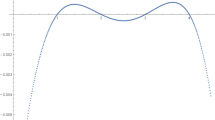Abstract
This paper presents a short, simple, and general proof showing that the control polygons generated by subdivision and degree elevation converge to the underlying splines, box-splines, or multivariate Bézier polynomials, respectively. The proof is based only on a Taylor expansion. Then the results are carried over to rational curves and surfaces. Finally, an even shorter but as simple proof is presented for the fact that subdivided Bézier polygons converge to the corresponding curve.
Similar content being viewed by others
References
W. Boehm, Inserting new knots into B-spline curves, Comp. Aided Design 12(1980)199–201.
A.S. Cavaretta, W. Dahmen and C.A. Micchelli, Stationary subdivision, Memoirs Amer. Math. Soc. 93(1991)453.
E. Cohen, T. Lyche and R.F. Riesenfeld, Discrete B-splines and subdivision techniques in computeraided geometric design and computer graphics, Comp. Graphics Image Proc. 14(1980)87–111.
E. Cohen and L.L. Schumaker, Rates of convergence of control polygons, Comp. Aided Geom. Design 2(1985)229–235.
W. Dahmen, N. Dyn and D. Levin, On the convergence rates of subdivision algorithms for box spline surfaces, Constr. Approx. 1(1985)305–322.
W. Dahmen, Subdivision algorithms converge quadratically, J. Comp. Appl. Math. 16(1986) 145–158.
C. De Boor, Cutting corners always works, Comp. Aided Geom. Design 4(1987)125–131.
G. Farin, Subsplines über Dreiecken, Diss., TU Braunschweig (1979).
G. Farin, Triangular Bernstein-Bézier patches, Comp. Aided Geom. Design. 3(1986)83–127.
G. Farin,Curves and Surfaces for Computer Aided Geometric Design—A Practical Guide, 2nd ed. (Academic Press, 1990).
J.A. Gregory and R. Qu, Non-uniform corner cutting, Technical Report, Brunel University (1988).
J.M. Lane and R.F. Riesenfeld, A theoretical development for the computer generation of piecewise polynomial surfaces, IEEE Trans. Pattern Anal. Machine Int. PAMI-2(1980)35–45.
C. Loop, private communication (1988).
C.A. Micchelli and H. Prautzsch, Uniform refinement of curves, Lin. Alg. Appl. 114(1989)841–870.
H. Prautzsch and B. Piper, A fast algorithm to raise the degree of spline curves, Comp. Aided Geom. Design 8(1991)253–265.
H. Prautzsch, The generation of box spline surfaces—A generalization of the subdivision algorithm, Report No. 07/04, TU Braunschweig (1984).
H. Prautzsch, Unterteilungsalgorithmen für multivariate Splines—Ein geometrischer Zugang, Diss., TU Braunschweig (1984).
H. Prautzsch, Linear subdivision, Lin. Alg. Appl. 143(1991)223–230.
H. Prautzsch, On convex Bézier triangles, Math. Mod. Numer. Anal. 26(1992)23–36.
R. Schaback, Comment in Oberwolfach (June, 1992).
L.L. Schumaker,Spline Functions—Basic Theory (Wiley, 1981).
Author information
Authors and Affiliations
Rights and permissions
About this article
Cite this article
Prautzsch, H., Kobbelt, L. Convergence of subdivision and degree elevation. Adv Comput Math 2, 143–154 (1994). https://doi.org/10.1007/BF02519040
Issue Date:
DOI: https://doi.org/10.1007/BF02519040



